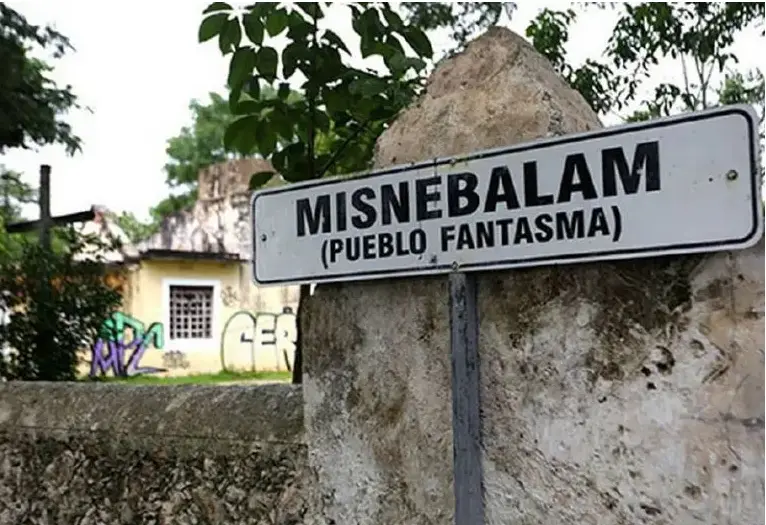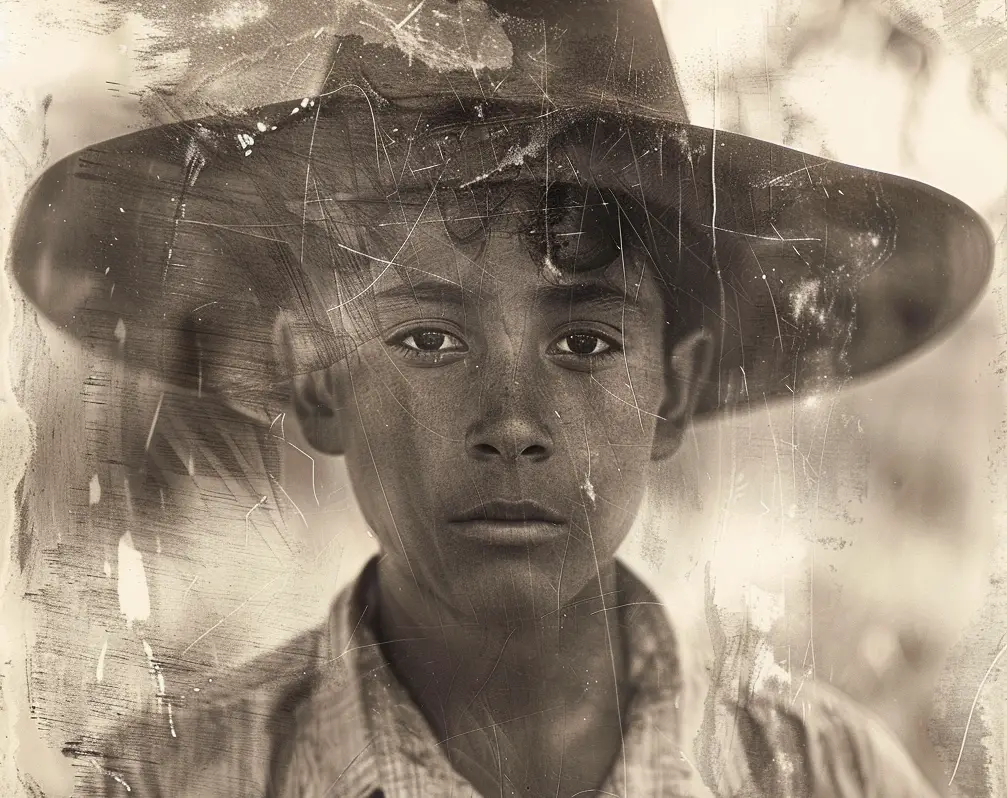Podcast: Play in new window | Download
Subscribe: Apple Podcasts | RSS
 Nestled in the dense vegetation of Yucatán lies the ghost town of Misnebalam, once the site of a thriving hacienda producing henequen, an agave plant whose fibers are used for making rope and other items. The plantation and the small town surrounding it are now shrouded in mystery and legends. The overgrown paths that lead to Misnebalam are a stark contrast to its former prosperity, with the ruins of the town standing as silent witnesses to its dramatic decline. Once a symbol of wealth and productivity, Misnebalam is now a place of eerie stillness. The modern visitor who walks into the town is now confronted by crumbling graffiti-ridden buildings and pentagrams drawn on concrete slabs alongside candle residue. In this episode of Mexico Unexplained we will delve into the history and legends of Misnebalam, exploring how this once vibrant community became a desolate ghost town, haunted by stories of murder, betrayal, and the supernatural.
Nestled in the dense vegetation of Yucatán lies the ghost town of Misnebalam, once the site of a thriving hacienda producing henequen, an agave plant whose fibers are used for making rope and other items. The plantation and the small town surrounding it are now shrouded in mystery and legends. The overgrown paths that lead to Misnebalam are a stark contrast to its former prosperity, with the ruins of the town standing as silent witnesses to its dramatic decline. Once a symbol of wealth and productivity, Misnebalam is now a place of eerie stillness. The modern visitor who walks into the town is now confronted by crumbling graffiti-ridden buildings and pentagrams drawn on concrete slabs alongside candle residue. In this episode of Mexico Unexplained we will delve into the history and legends of Misnebalam, exploring how this once vibrant community became a desolate ghost town, haunted by stories of murder, betrayal, and the supernatural.
Located about 12 miles north of the capital of the state of Yucatán off the Mérida-Progreso Highway, a neglected and overgrown dirt road leads to the once prosperous site of Misnebalam. While the name may sound like an ancient Maya lost city, Misnebalam is one of the most mysterious modern ruined cities of Yucatán. The name does come from Yucatec Maya, though, and it is a combination of the words “miis” which means “cat”, “nej” meaning “tail” and “balam” which means “jaguar.” So, the words put together literally meant, “cat tail of the jaguar,” or more simply, “jaguar tail.” While many tourists and adventurers explore the area’s many ancient Maya ruins, Misnebalam attracts a different type of visitor, one who is enamored by modern decay and the thrill of discovering out-of-the way places not often frequented by ordinary sightseers such as vacationers who may be taking day trips from Cancun. On site there are currently 25 ruined buildings, including the roofless colonial-style hacienda mansion and dilapidated homes that housed entire families. At its height, the small settlement had a population of almost 200 people, and some of those ruined structures were once more functional buildings such as a store and a chapel. Most of the structures are made of stone, concrete and other 20th Century building materials. There is even a cenote on the property, which is a large, open fresh-water well common in the northern parts of the Yucatan Peninsula. The place was completely abandoned by around the year 2005, the henequen production having stopped many decades before. Jungle vegetation has taken over most of the ruined settlement of Misnebalam, much in the same way as it has in the ancient Maya ruins scattered throughout the neighboring countryside.
But what happened to Misnebalam that led it to decline and abandonment? Why was a place that was once so beautiful and abundant left desolate?
First, a little history. The hacienda of Misnebalam was founded in the year 1900 by Don Fidencio Gertrudis Márquez, a man who came from a local wealthy family of merchants and plantation owners. As previously mentioned, the plantation located at Misnebalam was focused on the cultivation and production of henequen, a species of agave that is used in the manufacture of fabrics to make various finished products. Don Fidencio employed dozens of local families to work his fields and like so many similar haciendas at the time, he often had laborers who were recent immigrants from abroad or who came from other parts of Mexico, including indigenous people from the northern part of the country who were considered “rebels” by the Mexican government and were shipped to the Yucatan plantations as semi-slave laborers. Oral history in the area affirms that Don Fidencio was a benevolent landowner who took care of his people and treated his laborers with respect and fairness. In fact, the story goes that many people wanted to work at the Misnebalam plantation because of the higher wages and better living conditions there. Tragedy would strike some two decades into this hacienda project when an unfortunate event befell Don Fidencio, his son and one of his workers. On October 22, 1921, the trio were walking on an old stone sacbé – a road constructed by  the ancient Maya – which led from the small town of San Ignacio to the main Misnebalam plantation house. They were about halfway to the main house when they were ambushed by a group of men armed with machetes and guns who disappeared into the jungle as quickly as they appeared. Don Fidencio suffered mortal injuries from this attack. They never found the people who committed the crime and the whole plantation was in mourning over the death of the larger-than-life owner. Things were not the same after Don Fidencio’s death, and the plantation was taken over by one of his sons who preferred to live in Mérida as an absentee owner. While he was enjoying everything high society had to offer in the capital city, the plantation was being run by brutal overseers, and the workers longed for the better days of times past. Economic conditions then got worse throughout the 1920s which caused much tension between labor and management at the hacienda. People began saying that Misnebalam was cursed because Don Fidencio’s life was cut short. Not only were times harder, but accidents were also more frequent and so was sickness among the workers. Many people left the hacienda and the small settlement because they believed there was an ill specter hanging over the place.
the ancient Maya – which led from the small town of San Ignacio to the main Misnebalam plantation house. They were about halfway to the main house when they were ambushed by a group of men armed with machetes and guns who disappeared into the jungle as quickly as they appeared. Don Fidencio suffered mortal injuries from this attack. They never found the people who committed the crime and the whole plantation was in mourning over the death of the larger-than-life owner. Things were not the same after Don Fidencio’s death, and the plantation was taken over by one of his sons who preferred to live in Mérida as an absentee owner. While he was enjoying everything high society had to offer in the capital city, the plantation was being run by brutal overseers, and the workers longed for the better days of times past. Economic conditions then got worse throughout the 1920s which caused much tension between labor and management at the hacienda. People began saying that Misnebalam was cursed because Don Fidencio’s life was cut short. Not only were times harder, but accidents were also more frequent and so was sickness among the workers. Many people left the hacienda and the small settlement because they believed there was an ill specter hanging over the place.
One of the things that went wrong at Misnebalam a decade or so after Don Fidencio’s passing – as noted in the local lore – was the tragic death of a 13-year-old boy named Juliancito who worked in the fields alongside his parents. In one version of the story, the happy-go-lucky, handsome Juliancito was brutally abused and molested by a foreman. The boy went to the priest in charge of the small chapel at Misnebalam and told him of the repeated maltreatment by the overseer, at which point the priest went to the boy’s parents. The parents became angry at the foreman and at the boy for allowing this to happen, and Juliancito, ashamed and depressed, committed suicide the next day by hanging himself in the main patio of the hacienda. The day of the suicide, the foreman left the plantation, never to be seen of or heard from again. In another version of the story, it was the priest at the chapel who was molesting young Juliancito, and the priest denied the rumors of this abuse after the boy killed himself. In this version of the story, the priest became angry at the people of Misnebalam for blaming him for Juliancito’s suicide and told them that God would have His reckoning with them for tarnishing the reputation of a man of the cloth. Some saw the priest’s reaction as a sort of added curse that was layered upon the town. Whichever story one chooses to believe, the result is the same: the grounds of Misnebalam became haunted by Juliancito’s ghost. The sightings of the boy’s ghost allegedly became more intense and dramatic over time, and this restless and angry spirit is cited as one of the reasons that contributed to the eventual abandonment of the town. Sightings of the ghost of Juliancito supposedly occur even into the 21st Century. Visitors to the abandoned town have reported the spectral image of a very emotional teenage boy, and these sightings have been associated with objects flying through the air, mysterious orbs and even spontaneous fires.
 Another much-discussed legend surrounding Misnebalam is that of the “Black Monk.” This specter began appearing in the 1950s on top of the settlement’s chapel and has been described as a monk from the 17th Century dressed in a black robe. Those who believe in the priestly angle to the Juliancito suicide story think that the monk started appearing after the death of the disgruntled and angry priest who was accused of abusing the young boy a few decades earlier. The Black Monk appears only at night and historically he has been seen standing with outstretched arms on the roof of the small Misnebalam church. Sometime around the year 2010 the roof of the chapel collapsed, and those who have been on the property at night since then have claimed to have seen the monk floating above the ruined building or walking around the grounds of this simple former house of worship.
Another much-discussed legend surrounding Misnebalam is that of the “Black Monk.” This specter began appearing in the 1950s on top of the settlement’s chapel and has been described as a monk from the 17th Century dressed in a black robe. Those who believe in the priestly angle to the Juliancito suicide story think that the monk started appearing after the death of the disgruntled and angry priest who was accused of abusing the young boy a few decades earlier. The Black Monk appears only at night and historically he has been seen standing with outstretched arms on the roof of the small Misnebalam church. Sometime around the year 2010 the roof of the chapel collapsed, and those who have been on the property at night since then have claimed to have seen the monk floating above the ruined building or walking around the grounds of this simple former house of worship.
In addition to the 2 famous legends connected with Misnebalam, when there was still a small population there people also reported other supernatural events, including strange voices echoing from abandoned buildings, sudden icy cold breezes coming out of nowhere and small orbs of light floating out of the surrounding jungle. Economic conditions aside, the total abandonment of the town happened when the last family could no longer take the strange phenomena that they were confronted with on a weekly basis. Some more recent visitors to the abandoned town claim to have experienced similar things as Misnebalam’s last residents: the voices, the chilling breezes and the orbs of light. Also, some people claim to have seen distant lights among the ruins and when they get closer the lights are no longer there.
Besides the legends, the reports of paranormal occurrences and other stories of high strangeness associated with Misnebalam, there is a modern-day occult overlay to this place. Visitors often report seeing the remnants of Satanic rituals having been performed at the site including pentagrams, upside down crosses and the clumps of wax that are the residue of candles used in ceremonies. Some allege that a local group of devil-worshippers from the city of Mérida has turned Misnebalam into a pilgrimage destination, while others believe that the satanic paraphernalia found at the site are the items that larping teenage kids have left behind. The few sensitives and mediums who have visited the place have reported dark energies and malevolent unseen forces that are seemingly in control. Would those energies and forces cause the satanic rituals to be practiced there, or are they the result of them? Those who believe that the area was once consecrated to the ancient Maya deity Ix Chel, who is the goddess of suicide, among other things, think that these evil forces and entities have been around a lot longer than the 1921 death of Don Fidencio, and possibly stretch back a thousand years or more into prehistory.
Misnebalam stands as a poignant reminder of the fragile nature of prosperity and the enduring power of legends. From its heyday as a bustling henequen hacienda to its current status as an enigmatic ghost town, the story of Misnebalam is steeped in mystery and tragedy. The tales of Don Fidencio’s murder, the haunting spirit of Juliancito, the elusive Black Monk, and recent demonic activity add layers of intrigue to the ruins. While modern-day visitors can only imagine the vibrancy that once filled its streets, the legends and ruins of Misnebalam continue to captivate and chill those who dare to explore its haunted paths.
REFERENCES
Pacheco Ortiz, Mariana. “Misnebalam, el misterioso pueblo fantasma de Yucatán: ¿qué pasó?” In Diario de Yucatán, 5 Oct 2023 (in Spanish)
